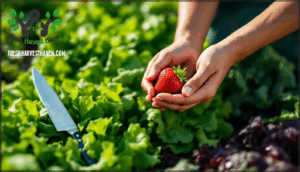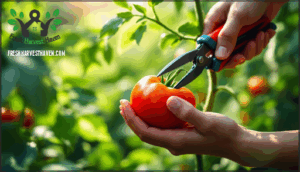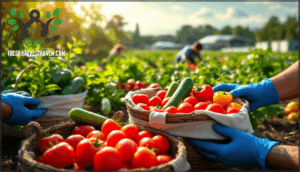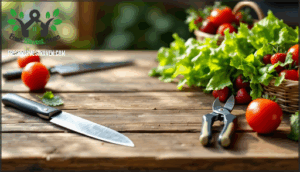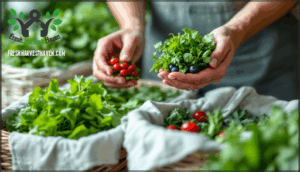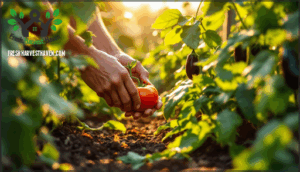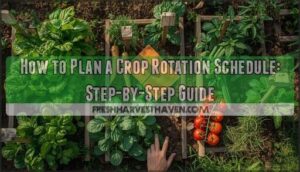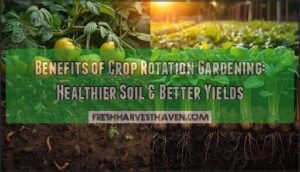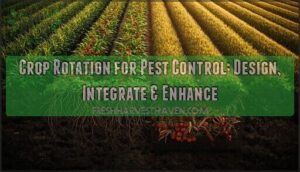This site is supported by our readers. We may earn a commission, at no cost to you, if you purchase through links.
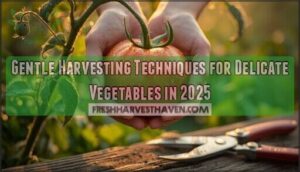
This difference becomes even more pronounced with truly delicate crops—think tender lettuce leaves, fragile strawberries, and paper-thin pea pods that bruise at the slightest rough treatment. The way you approach harvesting these sensitive vegetables determines whether they make it to your kitchen in peak condition or arrive damaged and disappointing.
Mastering the right techniques, from choosing the best moment to supporting stems during cutting, transforms your harvest from a routine chore into a skill that protects your hard-earned produce.
Table Of Contents
Key Takeaways
- Harvest delicate vegetables during cool morning hours when plants are fully hydrated and crisp, which locks in better flavor and makes handling easier than waiting until afternoon heat has stressed the crops.
- Use sharp, clean tools like bypass pruners or scissors for thicker stems, but rely on gentle hand-picking for ultra-delicate items like strawberries and leafy greens to prevent bruising and tissue damage.
- Cool your harvest immediately after picking—methods like forced-air cooling, hydrocooling, or vacuum cooling can drop temperatures by 20-30°C within hours, essentially pausing the quality decline that starts the moment you pick.
- Match your harvesting approach to each crop’s specific ripeness signals, whether that’s color changes in tomatoes and peppers, proper leaf size in greens, or diameter in root vegetables, since timing directly impacts flavor and texture.
Best Times to Harvest Delicate Vegetables
Timing your harvest right can make all the difference between bland vegetables and flavor-packed produce. You’ll want to think about the time of day, how your crops look and feel, and where each vegetable sits in its ripening cycle.
Let’s break down what you need to watch for to catch your delicate vegetables at their absolute peak.
Morning Vs. Evening Harvesting
When you harvest matters just as much as how you do it, and the clock plays a bigger role in your vegetables’ flavor than you might think. Cool morning hours offer prime hydration and nutrient retention—your plants are crisp, firm, and less stressed after the night’s recovery.
Evening harvesting works too, but temperature control becomes trickier as daytime heat lingers. Morning wins for flavor differences and gentle harvesting since pest activity stays low and your vegetables haven’t wilted under the sun’s pressure.
Visual and Sensory Maturity Indicators
You’ll spot maturity through color assessment—think chlorophyll fading and carotenoid development showing ripeness. Texture evaluation matters too: firm vegetables with slight give signal readiness, while overly soft means you’ve waited too long. Size indicators help with crops like bell peppers, where filled shoulders and blocky shapes confirm harvest optimization.
Professional growers use these sensory markers alongside ripeness detection methods for gentle harvesting success and proper postharvest care. Fruit growers rely on fruit skin color as a key indicator.
Crop-Specific Ripening Stages
Each vegetable follows its own ripening timeline, so knowing what to look for in tomatoes won’t help you much with your carrots or peppers. Tomatoes shift from green to their final tomato color—red, yellow, or pink—and you can pick them at the "blush" stage for great flavor profiles. Peppers develop deeper hues as they ripen, changing from green to red or yellow.
Leafy greens need harvesting when their leaves reach four inches before bolting, while root vegetables like carrots taste best at a one-inch root diameter.
Gentle Hand Harvesting Techniques
When you’re working with delicate vegetables, your hands become your most valuable tools. The way you treat each leaf, stem, and fruit directly affects quality and shelf life.
Let’s look at three key approaches that’ll help you harvest gently while keeping your work efficient.
Hand Picking Vs. Using Tools
When you’re standing in the garden deciding whether to use your hands or reach for a tool, the choice you make can mean the difference between a perfect harvest and a pile of bruised produce. Hand harvesting works best for strawberries and delicate leafy greens where bruising prevention matters most.
For crops with tougher stems, a sharp harvest knife improves tool efficiency and reduces plant damage. Match your technique selection to crop sensitivity—gentle harvesting isn’t one-size-fits-all, and smart choices lower labor costs while protecting quality.
Supporting Stems and Minimizing Damage
One wrong move as you reach for that ripe tomato, and you’ll snap the stem clean off—or worse, send the whole plant toppling sideways. Always cradle the fruit with one hand while making clean cuts with sharp pruners—that’s bruise prevention and stem support working together.
Cradle the fruit with one hand while making clean cuts with sharp pruners to prevent bruising and support stems
Gentle transport starts right here: avoid jostling, keep manual harvesting smooth, and your post-harvest treatment becomes easier when plant damage never happens in the first place.
Efficient Harvesting for Labor and Quality
If you want to slash labor costs—which can eat up 29% of production expenses—then supervised harvesting and proper training efficiency gains are non-negotiable. Selective picking benefits show up fast: manual harvesting cuts mechanical damage by 20% compared to machines. Train your crew well, and you’ll see a postharvest loss decrease from that risky 0.4–35% range, plus an 18% drop in bruised or broken produce.
First-rate harvesting requires attention to produce maturity levels. Gentle harvesting paired with smart postharvest treatment keeps quality high and waste low.
Essential Tools and Their Proper Use
The right tools make all the difference when you’re harvesting delicate vegetables—sharp edges mean clean cuts, and clean cuts mean healthier plants and better-quality produce. But having the tools is only half the battle; you need to know how to use and maintain them properly.
Let’s look at what belongs in your harvest toolkit and how to keep everything working smoothly.
Choosing Sharp Knives, Pruners, and Scissors
A dull blade tears plant tissue and invites disease, but the right sharp tool makes all the difference in preserving your harvest’s quality and your garden’s health. Here’s what you’ll want to reach for when manually harvesting delicate crops:
- Stainless steel knives with comfortable grips reduce hand fatigue during long picking sessions
- Bypass pruners make clean cuts on thicker stems without crushing tissue
- Fine-tipped scissors excel for snipping delicate herbs and leafy greens
- Carbon steel blades hold their edge longer, though they require more regular knife sharpening
Clean, sharp tools are essential for effective hand harvesting and proper vegetable harvesting techniques.
Cleaning and Maintaining Harvesting Tools
Your tools don’t work their magic if you let them rust, dull, or accumulate yesterday’s plant residue—cleaning and maintenance isn’t optional, it’s what keeps your harvest safe from disease.
Wipe blades with rubbing alcohol after each use for proper tool sanitation, and store gardening tools in a dry spot for rust prevention. Regular sharpening techniques keep edges clean and sharp, while checking grip maintenance prevents splinters.
These simple harvesting techniques protect your crops and make vegetable harvesting techniques more effective season after season.
Using Baskets and Containers for Transport
The container you choose can make the difference between picture-perfect produce and a basket of bruises before you even reach the kitchen. Here’s what works for gentle harvesting and efficient transport:
- Container material matters—use shallow, breathable baskets or soft-lined buckets that cushion delicate vegetables during manual harvesting.
- Size considerations prevent overcrowding—smaller containers reduce stacking weight and minimize pressure on fragile crops.
- Stacking methods save your harvest—layer gently, avoid piling heavy produce on top, and keep postharvest care smooth by preventing bruising from the start.
Smart vegetable harvesting techniques begin with the right transport system.
Post-Harvest Handling and Storage Tips
Once you’ve harvested those perfect vegetables, the clock starts ticking on freshness. The next few hours make all the difference between crisp, flavorful produce and something that’s already losing its edge.
Here’s how to treat your delicate crops right after they leave the garden.
Immediate Cooling Methods
Getting your freshly picked vegetables cool fast is like hitting pause on their internal clock. Forced-air cooling drops temperatures by up to 30°C within 2-8 hours, perfect for leafy greens packed in vented containers. Hydrocooling benefits include cutting core temps from 30°C to below 10°C in just 45 minutes for crops like carrots and broccoli. Ice cooling works wonders for high-respiration vegetables such as sweet corn, reaching 0-2°C in under 2 hours. Vacuum cooling is incredibly energy-efficient, cooling lettuce from 30°C to 3-4°C in 20-40 minutes—three times faster than conventional methods. For smaller operations during cool morning hours, evaporative methods can drop temperatures by 10°C below ambient when humidity stays under 50%.
These PostHarvest procedures preserve the quality you worked so hard to achieve with Gentle Harvesting and proper Vegetable Harvesting Techniques, giving your PostHarvest Care the solid foundation it needs.
| Cooling Method | Temperature Drop | Best For |
|---|---|---|
| Forced-air cooling | 30°C in 2-8 hours | Leafy greens, spinach |
| Hydrocooling | 30°C to <10°C in 45 min | Carrots, broccoli, celery |
| Ice cooling | To 0-2°C in <2 hours | Sweet corn, broccoli |
| Vacuum cooling | 30°C to 3-4°C in 20-40 min | Lettuce, baby greens |
Cleaning and Drying Delicate Produce
Once your produce hits the perfect temperature, cleaning away field debris without damaging those tender leaves becomes the next step in preserving what you’ve grown. Proper care starts with Gentle Rinsing under cool water—no soaking that waterlogs your harvest. Water Quality matters more than you’d think for Preventing Spoilage.
Your PostHarvest Care checklist for Maintaining Freshness:
- Remove soil debris gently before rinsing
- Rinse vegetables under cool, clean water quickly
- Pat dry thoroughly with clean towels
- Never soak delicate produce for extended periods
These Drying Methods protect the quality your Vegetable Harvesting and Gentle Harvesting techniques worked to preserve.
Storing by Crop Type for Freshness
Different vegetables need different homes after drying—leafy greens wilt fast in warm spots while root crops can endure weeks in cool darkness if you store them right.
Leafy Green Storage demands high humidity and cold temps, while Root Crop Storage thrives in slightly warmer, drier conditions. Fruiting Veg Storage falls somewhere between—tomatoes and peppers need moderate Humidity Level Control.
Understanding Temperature Management and proper Postharvest care extends Storage life for every harvest you bring in.
Sustainable Harvesting and Garden Management
Your garden’s long-term health starts with the choices you make during harvest season. Smart practices protect your soil, cut down on waste, and keep chemicals out of your growing beds.
Here’s how to harvest sustainably while building a garden that thrives year after year.
Crop Rotation for Soil Health
Because healthy soil is the foundation of any thriving vegetable garden, crop rotation stands as one of your most powerful tools for sustainable agriculture and organic farming. Rotating crops strengthens nutrient cycling, improves soil structure, aids erosion management, and bolsters pest suppression—all contributing to better yield stability. Here’s what rotation does for your garden:
- Boosts nitrogen by 20–40% when you integrate legumes into your vegetable harvesting cycle
- Reduces soil-borne pests by up to 80% after several rotation years
- Cuts erosion in half compared to monoculture systems
- Increases grain yields by 12–17% while improving soil health long-term
Minimizing Waste and Chemical Use
Beyond rotating crops, smart harvesting practices let you minimize waste while slashing your reliance on chemical inputs—saving money and protecting the ecosystem around your garden. Composting methods transform kitchen scraps into organic fertilizers, while natural pest control and mindful techniques keep chemicals at bay. Water conservation and reduced packaging round out these sustainable gardening techniques.
These organic gardening principles work together, creating a healthier garden ecosystem.
| EcoFriendly Gardening Methods | Benefit | Impact |
|---|---|---|
| Composting Methods | Recycles nutrients | Cuts fertilizer costs 50% |
| Natural Pest Control | Reduces chemical use | Protects beneficial insects |
| Gentle Harvesting | Minimizes crop damage | Extends storage life |
| Water Conservation | Lowers resource use | Saves 30% on water bills |
| Organic Fertilizers | Enriches soil naturally | Improves long-term fertility |
Integrating Cover Crops and Eco-Friendly Practices
When you plant cover crops like clover or rye between growing seasons, you’re not just protecting bare soil—you’re building a living system that feeds future harvests while cutting down on the work chemicals used to do. These eco-friendly practices boost biodiversity and carbon sequestration naturally:
- Soil health improves as roots break up compaction and add organic matter
- Water conservation happens through better infiltration and reduced runoff
- Pest management gets easier when beneficial insects find habitat year-round
- Gentle harvesting thrives in balanced gardens where sustainable gardening techniques support soil conservation
Your vegetable harvesting rewards multiply when the ground beneath stays vibrant.
Frequently Asked Questions (FAQs)
How do weather conditions affect harvest timing?
Rainfall impact and soil moisture determine whether you can harvest without damaging roots or spreading disease.
Temperature effects and humidity levels influence ripeness, while frost risk demands immediate picking to save crops before cold strikes.
Can you harvest during light rain safely?
You can harvest during light rain, but it’s not ideal. Rain impact increases mold risk and tool slippage, affecting worker safety and produce safety.
Wait until conditions dry for better post-harvest treatment and to protect soil moisture levels.
What are signs of overripe delicate vegetables?
Overripe delicate vegetables show texture changes like mushiness, color fading or yellowing, visible bruising signs, off-putting aroma alterations, and taste degradation.
Proper care and harvest timing through postharvest care prevent these issues, maintaining quality with gentle harvesting and vegetable harvesting techniques.
How do you prevent pest damage during harvesting?
Keep pests at bay using pest exclusion netting, trap cropping, and repellent sprays before you step into the vegetable garden. Introduce beneficial insects and maintain strict sanitation practices.
During gentle harvesting, inspect plants carefully and use mindful techniques to spot issues early, protecting your post-harvest treatment efforts.
Should you fertilize before or after harvesting cycles?
You might worry that post-harvest fertilizing encourages weak, late-season growth—but timing actually depends on nutrient depletion and crop management goals. Fertilizer timing matters: apply after harvesting cycles to replenish soil moisture and plant needs, supporting sustainable fertilizing practices.
Always conduct soil testing before adding amendments to improve postharvest care and future vegetable harvesting success.
Conclusion
Think of your garden harvest like a delicate handshake—too firm, and you crush what matters most. Early mornings, sharp tools, and mindful hands aren’t just rituals—they’re the difference between produce that wilts by noon and crops that arrive bursting with life.
The gentle harvesting techniques for delicate vegetables you’ve learned here protect every cell, every flavor note, from garden to kitchen. Your patience at harvest time pays dividends in every bite, turning fragile stems and tender leaves into meals worth celebrating.

